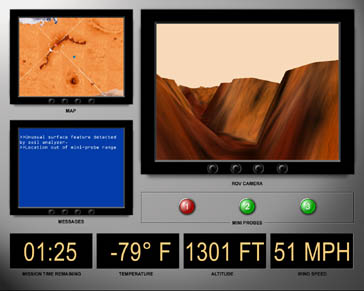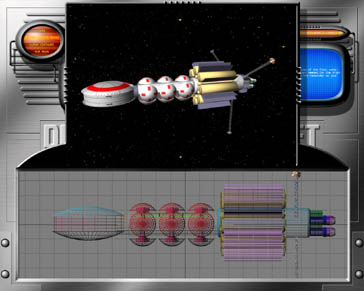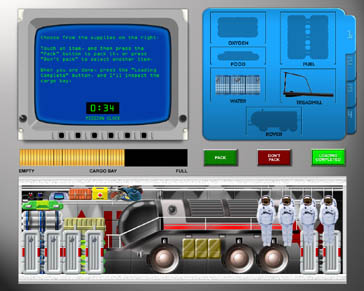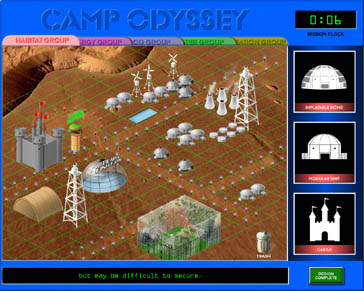Mars exhibits for Space: A Journey to Our Future
For the traveling exhibition, “Space: A Journey to our Future,” NETG produced several multimedia exhibits about the space exploration of the Planet Mars.
The “Mars Fly-Over” lets visitors take the controls of a Remote Operated Vehicle (ROV) to explore the surface of Mars. Using a joystick, visitors fly the ROV through a 3-D landscape that includes a canyon and a volcano. If the ROV detects an anomaly, the visitor can launch a mini-probe to get a closer look. The mini-probe may detect a Russian space rover, dust devil, or nutrients and transmits the data back to the visitor.
At the “Design a Spacecraft” exhibit, the visitor’s mission is to design a new vehicle for interplanetary travel. First they choose a destination – Mars, Jupiter and its moons, Alpha Centauri, or our Moon. Visitors go on to select the number of crew, type of propulsion system, and supply load. As decisions are made, 3-D wire frame models of a habitat module, cargo bay and propulsion system appear in the design window. When the spacecraft is complete, the visitor is presented with a fully rendered 3-D model of the final design.
“Pack for the Trip” lets visitors pack a Mars bound spacecraft with enough supplies to support a four-person crew for a two-year mission. The supplies include the essentials such as space suits, oxygen, water and food, a well as some questionable items such as pets and a surfboard. Information about each item helps the visitor determine what to pack. As the visitor chooses supplies, the empty cargo bay fills. When full, the cargo bay is inspected to determine if all the needed supplies are on board for a successful mission.
“Mars Base Camp” was developed for the younger visitors to the traveling exhibition “Space,” but has proved popular with visitors of all ages. In the exhibit, visitors choose one of three design terminals to build a colony at the base of Olympus Mons, in Valles Marineris canyon, or at the polar ice cap. To build a colony, visitors drag and drop animated icons onto the design grid. Icons are organized into five groups including habitat, energy, food, water, and recreation. When the Base Camp is complete, the visitor’s design appears on a large display monitor. NETG designed and produced all scripts, media elements, graphics and software for these exhibits. NETG also produced Spanish language versions of the programs for a tour of Mexico.













